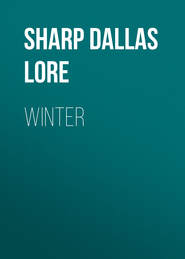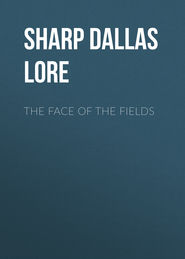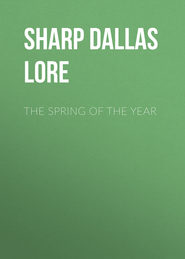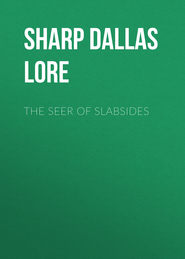По всем вопросам обращайтесь на: info@litportal.ru
(©) 2003-2024.
✖
Wild Life Near Home
Настройки чтения
Размер шрифта
Высота строк
Поля
There were numerous dark galleries branching off from this main hallway, piercing out into the ground. Into one of these I put my finger, by way of discovery, thinking I might find the nest. I did find the nest – and more. The instant my finger entered the hole a sharp twinge shot up my arm, and I snatched away my hand with a large meadow-mouse fastened to the end of my finger, and clinging desperately to her, lo! two baby mice, little bigger than thimbles.
In this mild and even temperature, four feet below the frozen surface of the garden, with never a care as to weather and provisions, dwelt this single family of meadow-mice. What a home it was! A mansion, indeed, with rooms innumerable, and a main hall girdling a very mountain of juicy, sugary beets. This family could not complain of hard times. Besides the beets, the mice had harvested for themselves a number of cribs of clover-roots. These cribs, or bins, were in the shape of little pockets in the walls of the great gallery. Each contained a cupful of the thick, meaty tap-roots of clover, cut into lengths of about half an inch. If the beets should fail (!), or cloy upon them, they had the roots to fall back on.
It was absolutely dark here, and worse; there was no way to get fresh air that I could see. Yet here two baby mice were born in the very dead of winter, and here they grew as strong and warm and happy as they would have grown had the season showered rose-petals instead of snowflakes over the garden above.
Hesperomys is the rather woodsy name of the white-footed or deer-mouse, a shy, timid little creature dwelling in every wood, who, notwithstanding his abundance, is an utter stranger to most of us. We are more familiar with his tracks, however, than with even those of the squirrel and rabbit. His is that tiny double trail galloped across the snowy paths in the woods. We see them sprinkled over the snow everywhere; but when have we seen the feet that left them? Here goes a line of the wee prints from a hole in the snow near a stump over to the butt of a large pine. Whitefoot has gone for provender to one of his storehouses among the roots of the pine; or maybe a neighbor lives here, and he has left his nest of bird-feathers in the stump to make a friendly call after the storm.
A bed of downy feathers at the heart of a punky old stump beneath the snow would seem as much of a snuggery as ever a mouse could build; but it is not. Instead of a dark, warm chamber within a hollow stump, Whitefoot sometimes goes to the opposite extreme, and climbs a leafless tree to an abandoned bird's nest, and fits this up for his winter home. Down by Cubby Hollow I found a wood-thrush's nest in a slender swamp-maple, about fifteen feet from the ground. The young birds left it late in June, and when Whitefoot moved in I do not know. But along in the winter I noticed that the nest looked suspiciously round and full, as if it were roofed over. Perhaps the falling leaves had lodged in it, though this was hardly likely. So I went up to the sapling and tapped. My suspicions were correct. After some thumps, a sleepy, frightened face appeared through the side of the nest, and looked cautiously down at me. No one could mistake that pointed nose, those big ears, and the round pop-eyes so nearly dropping out with blinking. It was Whitefoot. I had disturbed his dreams, and he had hardly got his wits together yet, for he had never been awakened thus before. And what could wake him? The black-snakes are asleep, and there is not a coon or cat living that could climb this spindling maple. Free from these foes, Whitefoot has only the owls to fear, and I doubt if even the little screech-owl could flip through these interlaced branches and catch the nimble-footed tenant of the nest.
In spite of the exposure this must be a warm bed. The walls are thick and well plastered with mud, and are packed inside with fine, shredded bark which the mouse himself has pulled from the dead chestnut limbs, or, more likely, has taken from a deserted crow's nest. The whole is thatched with a roof of shredded bark, so neatly laid that it sheds water perfectly. The entrance is on the side, just over the edge of the original structure, but so shielded by the extending roof that the rain and snow never beat in. The thrushes did their work well; the nest is securely mortised into the forking branches; and Whitefoot can sleep without a tremor through the wildest winter gale. Whenever the snow falls lightly a high white tower rises over the nest; and then the little haycock, lodged in the slender limbs so far above our heads, is a very castle indeed.
High over the nest of the white-footed mouse, in the stiffened top of a tall red oak that stands on the brow of the hill, swings another winter bed. It is the bulky oak-leaf hammock of the gray squirrel.
A hammock for a winter bed? Is there anything snug and warm about a hammock? Not much, true enough. From the outside the gray squirrel's leaf bed looks like the coldest, deadliest place one could find in which to pass the winter. The leaves are loose and rattle in the wind like the clapboards of a tumble-down house. The limb threatens every moment to toss the clumsy nest out upon the storm. But the moorings hold, and if we could curl up with the sleeper in that swaying bed, we should rock and dream, and never feel a shiver through the homespun blankets of chestnut bark that wrap us round inside the flapping leaves.
Be it never so cozy, a nest like this is far from a burrow – the bed of a fat, thick-headed dolt who sleeps away the winter. A glance into the stark, frozen top of the oak sends over us a chill of fright and admiration for the dweller up there. He cannot be an ease-lover; neither can he know the meaning of fear. We should as soon think of a sailor's being afraid of the shrieking in the rigging overhead, as of this bold squirrel in the tree-tops dreading any danger that the winter winds might bring.
There are winters when the gray squirrel stays in the hollow of some old tree. A secure and sensible harbor, this, in which to weather the heavy storms, and I wonder that a nest is ever anchored outside in the tree-tops. The woodsmen and other wiseacres say that the squirrels never build the tree-top nests except in anticipation of a mild winter. But weather wisdom, when the gray squirrel is the source, is as little wise as that which comes from Washington or the almanac. I have found the nests in the tree-tops in the coldest, fiercest winters.
It is not in anticipation of fine weather, but a wild delight in the free, wild winter, that leads the gray squirrel to swing his hammock from the highest limb of the tallest oak that will hold it. He dares and defies the winds, and claims their freedom for his own. From his leafless height yonder he looks down into the Hollow upon the tops of the swamp trees where his dizzy roads run along the angled branches, and over the swamp to the dark pines, and over the pines, on, on across the miles of white fields which sweep away and away till they freeze with the frozen sky behind the snow-clouds that drift and pile. In his aery he knows the snarl and bite of the blizzard; he feels the swell of the heaving waves that drive thick with snow out of the cold white north. Anchored far out in the tossing arms of the strong oak, his leaf nest rocks in the storm like a yawl in a heaving sea.
But he loves the tumult and the terror. A night never fell upon the woods that awed him; cold never crept into the trees that could chill his blood; and the hoarse, mad winds that swirl and hiss about his pitching bed never shook a nerve in his round, beautiful body. How he must sleep! And what a constitution he has!
A BIRD OF THE DARK
The world is never more than half asleep. Night dawns and there is almost as wide a waking as with the dawn of day. We live in the glare till it leaves us blind to the forms that move through the dark; we listen to the roar of the day till we can no longer hear the stir that begins with the night. But here in the darkness is life and movement, – wing-beats, footfalls, cries, and calls, – all the wakefulness, struggle, and tragedy of the day.
Whatever the dusk touches it quickens. Things of bare existence by day have life at night. The very rocks that are dead and inanimate in the light get breath and being in the dark. What was mere substance now becomes shadow, and shadow spirit, till all the day's dead live and move. The roads, fences, trees, and buildings become new creatures; landmarks, distances, and places change; new odors are on the winds; strange lights appear; soft footsteps pass and repass us; and hidden voices whisper everywhere. The brightest day is not more awake; at high noon we are not more alert.
One of the commonest of these night sounds is the cry of the whippoorwill. From the middle of April to the end of September it rings along the edge of the clearing; but how seldom we have seen the singer! To most of us it is only a disembodied voice. Night has put her spell upon the whippoorwills and changed them from birds into wandering shadows and voices. There is something haunting in their call, a suggestion of fear, as though the birds were in flight, pursued by a shape in the gloom. It is the voice of the lost – the voice of the night trying to find its way back to the day. There is snap enough in the call if you happen to be near the bird. Usually the sound comes to us out of the darkness and distance – the loneliest, ghostliest cry of all the night.
It is little wonder that so many legends and omens follow the whippoorwill. How could our imaginations, with a bent for superstition, fail to work upon a creature so often heard, so rarely seen, of habits so dark and uncanny?
One cannot grow accustomed to the night. The eager, jostling, open-faced day has always been familiar; but with the night, though she comes as often as the day, no number of returns can make us acquainted. Whatever is peculiarly her own shares her mystery. Who can get used to the bats flitting and squeaking about him in the dusk? Or who can keep his flesh from creeping when an owl bobs over him in the silence against a full moon? Or who, in the depths of a pine barren, can listen to a circle of whippoorwills around him, and not stay his steps as one lost in the land of homeless, wailing spirits? The continual shifting of the voices, the mocking echoes, and the hiding darkness combine in an effect altogether gruesome and unearthly.
One may hear the whippoorwill every summer of his life, but never see the bird. It is shy and wary, and, with the help of the darkness, manages to keep strangely out of sight. Though it is not unusual to stumble upon one asleep by day, it is a rare experience to surprise one feeding or singing at night.
One evening I was standing by a pump in an open yard, listening to the whippoorwills as they came out to the edge of the woods and called along the fields. The swamp ran up so close on this side of the house that faint puffs of magnolia and wild grape could be strained pure from the mingling odors in the sweet night air. The whippoorwills were so near that the introductory chuck and many of the finer, flute-like trills of their song, which are never heard at a distance, were clear and distinct. Presently one call sounded out above the others, and instantly rang again, just behind a row of currant-bushes not ten feet away.
I strained my eyes for a glimpse of the creature, when swift wings fanned my face, and a dark, fluffy thing, as soft and noiseless as a shadow, dropped at my feet, and exploded with a triple cry of Whip-poor-will! that startled me. It was a rapid, crackling, vigorous call that split through the night as a streak of lightning through a thunder-cloud. The farmers about here interpret the notes to say, Crack-the-whip! and certainly, near by, this fits better than Whip-poor-will!
The bird was flitting about the small platform upon which I stood. I remained as stiff as the pump, for which, evidently, it had mistaken me. It was not still a moment, but tossed back and forth on wings that were absolutely silent, and caught at the insects in the air and uttered its piercing cry. It leaped rather than flew, sometimes calling on the wing, and always upon touching the ground.
This is as good a view of the bird as I ever got at night. The darkness was too thick to see what the food was it caught, or how it caught it. I could not make out a pose or a motion more than the general movements about the pump. The one other time that I have had a good look at the bird, when not asleep, showed him at play.
It was an early August morning, between two and three o'clock. The only doctor in the village had been out all night at a little town about five miles away. He was wanted at once, and I volunteered to get him.
Five miles is pure fun to a boy who has run barefoot every one of his fifteen summers; so I rolled up my trousers, tightened my belt, and bent away for Shiloh at an easy dog-trot that, even yet, I believe I could keep up for half a day.
There was not a glimmer in the east when I started. I had covered three miles, and was entering a long stretch of sprout-land when the dawn began. The road was dusty, and the dew-laid powder puffed beneath the soft, swift pats of my feet. Things began to stand out with some distinctness now as the pale light brightened. No wagons had been along, and every mark of the night was plain. Here and there were broad, ragged-edged bands across the road – the trails of the wandering box-turtles. I saw the smooth, waving channel left by a snake that had just gone across. Here and there were bunches of rabbit tracks, and every little while appeared large spots in the road, where some bird had been dusting itself.
Suddenly I made a sharp turn, and almost ran over a whippoorwill concealed in a very cloud of dust which she was flirting up with her wings. This explained the spots back along the road. The bird flew up and settled a few yards ahead of me, and took another hasty dip. This she kept up for nearly a quarter of a mile.
The road was alive with whippoorwills. It was their bathing-hour, and playtime, too. The serious business of the night was done; they had hunted through the first hours, and now it was time to be social. The light was coming rapidly, and so was bedtime; but they called and capered about me, playing away the narrowing night to the very edge of day.
On my return, an hour later, the sun was looking over the tops of the "cut-offs," but he did not see a whippoorwill. They were all roosting lengthwise upon the logs and stumps back among the bushes.
These unnatural, unbirdlike habits of the whippoorwill are matched by the appearance of the bird. The first time one sees a whippoorwill he questions whether its shape and color are the result of its nocturnal life or whether it took to the night to hide its unbeautiful self from the gaze of the day.
It has ridiculously short legs, a mere point of a bill, and a bristled, head-dividing gap that would shame a frog. Looked at in the daylight, its color, too, is a meaningless mixture, as unreal and half done as the rest of the creature. But we should not be so hasty in our judgment. There is design in all things in nature; utility is the first law of creation: and the discovery of plan and purpose is the highest appreciation of beauty.
The whippoorwill's dress must be criticized from the view-point of its usefulness to the bird; then it becomes one of the most exquisitely artistic garments worn. Compare it with that of any other bird, and your wonder at it grows. Another such blending of light and shadow cannot be found. The night herself seems to have woven this robe out of warp from the strands of early dawn and of woof spun from the twilight.
The whippoorwill cannot change the color of its dress with the passing clouds, nor match it with the light green of unfolding leaves and the deep bronze of old tree-trunks, as the chameleon can. But the bird has no need of such control. It is always in harmony with its surroundings. In the falling twilight it seems a shadow among the shadows; in the breaking dawn it melts into the gray half-light, a phantom; at midnight it is only an echo in the dark; and at noontime you would pass the creature for a mossy knot, as it squats close to a limb or rail, sitting lengthwise, unlike any bird of the light.
We need not expect a bird of such irregular habits as the whippoorwill to have the normal instincts of birds, even with regard to its offspring. A bird given to roaming about at night, the companion of toads and bats and spooks, is not one that can be trusted to bring up young. You cannot count much on the domesticity of a bird that flits around with the shadows and fills the night with doleful, spellbinding cries.
The nest of the whippoorwill is the bare ground, together with whatever leaves, pebbles, or bits of wood happen to be under the eggs when they are laid. I found a nest once by the side of a log in the woods, and by rarest good fortune missed putting my foot upon the eggs. Here there was no attempt at nest-building, not even a depression in the earth. There were two of the eggs, – the usual number, – long and creamy white, with mingled markings of lavender and reddish brown. Here, upon the log, one of the birds dozed away the day, while the mate on the nest brooded and slept till the gloaming.
The effect of this erratic life in the forest glooms and under the cover of night has been to make the whippoorwill careless of her home and negligent of her young. She has become a creature of omen, weird and wakeful, lingering behind the time of superstition to keep myths moving in our scanty groves and mystery still stirring through the dark rooms of the night.
THE PINE-TREE SWIFT
In any large museum you may see the fossil skeletons, or the casts of the skeletons, of those mammoth saurians of the Mesozoic Age. But you can go into the pine barrens any bright summer day and capture for yourself a real live saurian. The gloom of the pines is the lingering twilight of that far-off time, and the pine-tree lizard, or swift, is the lineal descendant of those reptile monsters who ruled the seas and the dry land before man was.
Throughout southern New Jersey the pine-tree swifts abound. The worm-fences, rail-piles, bridges, stone-heaps, and, above all, the pine-trees are alive with them. They are the true children of the pines, looking so like a very part of the trees that it seems they must have been made by snipping off the pitch-pines' scaly twigs and giving legs to them. They are the aborigines, the primitive people of the barrens; and it is to the lean, sandy barrens you must go if you would see the swifts at home.
In these wide, silent wastes, where there are miles of scrub-pine without a clearing, where the blue, hazy air is laden with the odor of resin, where the soft glooms are mingled with softer, shyer lights, the swifts seem what they actually are – creatures of another, earlier world. When one darts over your foot and scurries up a tree to watch you, it is easy to imagine other antediluvian shapes moving in the deeper shadows beyond. How they rustle the leaves and scratch the rough pine bark! They hurry from under your feet and peek around the tree-trunks into your face, their nails and scales scraping, while they themselves remain almost invisible on the deep browns of the pines; and if you are inclined to be at all nervous, you will start and shiver.
The uncanny name "lizard" is partly accountable for our unpleasant feelings toward this really intelligent and interesting little beast. If he were more widely known as "swift," Sceloporus would be less detested. The z in "lizard" adds a creepy, crawly, sinister something to the name which even the wretched word "snake" does not suggest. "Swift," the common name in some localities, is certainly more pleasing, and, at the same time, quite accurately descriptive.
There is nothing deadly nor vicious, nor yet unlovely, about the swift, unless some may hate his reptile form and his scales. But he is strangely dreaded. The mere mention of him is enough to stampede a Sunday-school picnic. I know good people who kill every swift they meet, under the queer religious delusion that they are lopping off a limb of Satan. "All reptiles are cursed," one such zealot declared to me, "and man is to bruise their heads." The good book of nature was not much read, evidently, by this student of the other Good Book.
The swift is absolutely harmless. He is without fang, sting, or evil charm. He is not exactly orthodox, for he has a third eye in the top of his head, the scientists tell us; but that eye is entirely hidden. It cannot bind nor leer, like Medusa. Otherwise the swift is a perfectly normal little creature, about six inches long from tip to tip, quick of foot, scaly, friendly, wonderfully colored in undulating browns and blues, and looking, on the whole, like a pretty little Noah's-ark alligator.
On the south side of the clump of pines beyond Cubby Hollow is a pile of decaying rails where I have watched the swifts, and they me, for so many seasons that I fancy they know me. Dewberry-vines and Virginia creeper clamber over the pile, and at one end, flaming all through July, burns a splendid bush of butterfly-weed. The orange-red blossoms shine like a beacon against the dark of the pines, and lure a constant stream of insect visitors, who make living for the swifts of this particular place rich and easy while the attraction lasts.
Any hot day I can find several swifts here, and they are so tame that I can tickle them all off to sleep without the slightest trouble. They will look up quickly as I approach, fearless but alert, with head tilted and eyes snapping; but not one stirs. With a long spear of Indian grass I reach out gently and stroke the nearest one. Shut go his eyes; down drops his head; he sleeps – at least, he pretends to. This is my peace greeting. Now I may sit down, and life upon the rail-pile will go normally on.
Upon the end of a rail, so close to a cluster of the butterfly-weed blossoms that he can pick the honey-gatherers from it, – as you would pick olives from a dish on the table, – lies a big male swift without a tail. He lost that member in an encounter with me several weeks ago. A new one has started, but it is a mere bud yet. I know his sex by the brilliant blue stripe down each side, which is a favor not granted the females. The sun is high and hot. "Fearfully, hot," I say under my wide straw hat. "Delightfully warm," says the lizard, sprawling over the rail, his legs hanging, eyes half shut, every possible scale exposed to the blistering rays, and his bud of a tail twitching with the small spasms of exquisite comfort that shoot to the very ends of his being.











